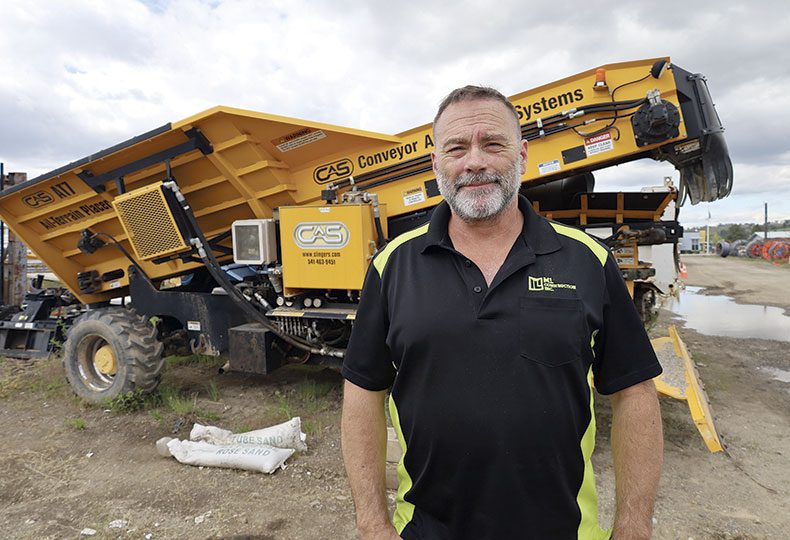
Home » M&L Construction starts fiber optic build-out valued at up to $70M
M&L Construction starts fiber optic build-out valued at up to $70M
Utility contractor's project for TDS to take up to 10 years to complete

Scot Hattenburg, president and co-owner of M&L Construction, says the company is adding fiber optic infrastructure in Spokane and Spokane Valley.
| Karina EliasJune 6, 2024
M&L Construction Inc., of Spokane, has been selected to build a fiber-optic network for homes and businesses by the internet service provider TDS Fiber, says Scot Hattenburg, president and co-owner of M&L Construction.
The $60 million to $70 million project, which will build the TDS fiber network infrastructure in Spokane and Spokane Valley, started in October near Spokane City Hall. Hattenburg says it will take up to 10 years to complete the entire project for TDS Fiber.
According to the city of Spokane, TDS’s build-out schedule calls for the company's service to reach 70% of the city’s residential units within five years. The project will require about 1,100 miles of aerial and underground fiber cable within the city.
Hattenburg says M&L has completed several fiber optic projects over the years. He says the company has earned a reputation for its quality of work and for leaving roads and people’s backyards seemingly undisturbed once they’ve finished.
“It’s going to be a process, but there’s not a road in this town that we haven’t crossed, dug, or done something with,” Hattenburg says. “We believe in it because we live here and want to make sure that we leave it better for our kids.”
Currently, most internet service is delivered through copper wiring that was laid during development and provides service to phone lines and cable television, Hattenburg explains. However, when copper gets hot, transmission rates can begin to decline and service becomes slow. Fiber-optic cables transmit data by sending pulses of light through thin glass or plastic strands called optical fibers, allowing it to travel long distances without weakening.
“What everybody is going back and doing now is using fiber optics, because with fiber optics, you’re at the speed of light,” Hattenburg says.
He says an important aspect that helped M&L Construction secure the contract with TDS Fiber was securing a line of credit from Gesa Credit Union.
“We needed about a $1 million to $1.2 million line of credit to be able to pull this off,” he says. “They stepped in and believed in us.”
M&L Construction is located on a 3-acre lot at 4111 E. Dalke, in the Hillyard neighborhood, and has a second, 5-acre property in Hauser. M&L Construction employs about 55 people and currently has about 10 to 15 projects of varying size and type, including solar panel farm installation, commercial excavation, and a three-year project with Coeur d’Alene-based Intermax Networks to install a fiber optic network in Kootenai County.
The family's history of working within the utility industry dates back to Hattenburg's grandfather, Jack Hattenburg, who was a line foreman for Washington Water Power Co. for several decades before being electrocuted on the job.
In 1972, a few months after his grandfather's death, Hattenburg's father, Mel Hattenburg founded M&L Construction. Mel Hattenburg is now retired and has handed operations to sons Scot and Ray Hattenburg, who lead the business as president and vice president, respectively.
Scot Hattenburg, who started working in the family business while in high school in the 1980s and throughout his college years at Eastern Washington University, says he's committed to creating a safe workplace for his company and for the industry at large. He has served twice on the Washington state Dig Safe Committee, is a member of the Damage Prevention Institute, has lobbied in the Idaho State house in support of safe excavating statutes, and is a founding member of the National Utility Contractors Association of Eastern Washington and North Idaho, a trade organization that champions safety, education, training, advocacy, and networking.
Digging and building out an underground fiber-optic network mainly consists of employing directional boring, a trenchless method in which a drilling rig bores into the ground and creates a pathway for installing underground utilities like pipes, cables, or conduits. M&L Construction began using the technology in 1994.
“Directional boring is a fascinating tool,” Hattenburg says. “We can basically go underground and steer like we’re flying an airplane underground.”
The method requires constant vigilance as crews often drill around existing lines and utilities.
Because safety is a major focus of the company, Hattenburg says he hires based on attitude over experience. His wife, Stephanie Hattenburg, who joined the company seven years ago as project manager and human resources person, has been a driving force in fostering a safe and welcoming culture, he says.
Stephanie Hattenburg says, when she first started, there was a lot of infighting and discord among the crew. Having worked in 911 dispatch prior to coming to M&L Construction, Stephanie says she knew the importance of having a positive attitude and outlook in stressful situations.
“We’re really hiring for attitude,” she says. “It’s a lot of training, but you can teach pretty much anybody these skills. … Stuff can really go wrong out there and when it does, having that mindset and resilience to get through a tough time is important.”
As a result, M&L crew members refer to their team as a brotherhood in which everybody is helping and looking out for each other, she says.
While hiring people with less experience requires more training, she says it’s a team effort and is less taxing than hiring a seasoned worker who may already have their own ideas of how to do things and be used to working in toxic environments. Additionally, the company offers other benefits that help new hires get ahead, such as obtaining their commercial driver's license with M&L Construction. While most people would need to go to a driving school for a commercial driving license, M&L Construction is qualified to train drivers.
“A lot of our guys will work with them and come in on the weekends to get them enough driving hours to pass the test,” she says. “They really do take care of each other.”
Latest News Special Report Real Estate & Construction
Related Articles
Related Products
Related Events




![Brad head shot[1] web](https://www.spokanejournal.com/ext/resources/2025/03/10/thumb/Brad-Head-Shot[1]_web.jpg?1741642753)
